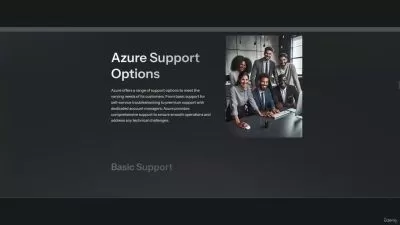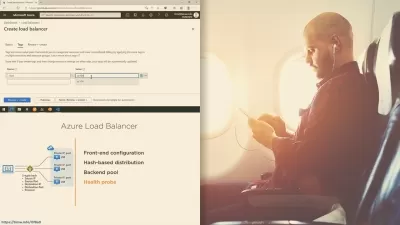Learn Azure in a Month of Lunches, 2E, video edition
Focused View
11:57:12
67 View
01 - Part 1. Azure core services.mp4
00:53
02 - Chapter 1. Before you begin.mp4
07:01
03 - Chapter 1. Creating your lab environment.mp4
05:22
04 - Chapter 1. A little helping hand.mp4
07:06
05 - Chapter 1. Virtualization in Azure.mp4
06:16
06 - Chapter 2. Creating a virtual machine.mp4
08:21
07 - Chapter 2. VM sizes.mp4
10:52
08 - Chapter 2. Creating an SSH key pair for authentication.mp4
05:14
09 - Chapter 2. Creating a VM from your web browser.mp4
07:05
10 - Chapter 2. Connecting to the VM and installing the web server.mp4
06:48
11 - Chapter 2. Allowing web traffic to reach the VM.mp4
05:28
12 - Chapter 2. Cleaning up resources.mp4
06:42
13 - Chapter 3. Azure Web Apps.mp4
06:15
14 - Chapter 3. Staging different versions with deployment slots.mp4
05:42
15 - Chapter 3. Creating a web app.mp4
11:57
16 - Chapter 3. Viewing diagnostic logs.mp4
09:07
17 - Chapter 4. Introduction to Azure Storage.mp4
09:13
18 - Chapter 4. Temporary disks and data disks.mp4
06:52
19 - Chapter 4. Azure Storage.mp4
09:16
20 - Chapter 4. Queue storage.mp4
06:13
21 - Chapter 5. Azure Networking basics.mp4
07:21
22 - Chapter 5. Virtual network interface cards.mp4
09:55
23 - Chapter 5. Securing and controlling traffic with network security groups.mp4
09:22
24 - Chapter 5. Building a sample web application with secure traffic.mp4
10:39
25 - Part 2. High availability and scale.mp4
00:52
26 - Chapter 6. Azure Resource Manager.mp4
09:02
27 - Chapter 6. Protecting resources with locks.mp4
05:07
28 - Chapter 6. Azure Resource Manager templates.mp4
08:14
29 - Chapter 6. Tools to build your own templates.mp4
09:41
30 - Chapter 7. High availability and redundancy.mp4
04:28
31 - Chapter 7. Infrastructure redundancy with Availability Zones.mp4
09:43
32 - Chapter 7. VM redundancy with Availability Sets.mp4
05:32
33 - Chapter 7. Distributing VMs across an Availability Set.mp4
08:22
34 - Chapter 7. Lab Deploying highly available VMs from a template.mp4
05:03
35 - Chapter 8. Load-balancing applications.mp4
09:41
36 - Chapter 8. Creating and configuring health probes.mp4
07:50
37 - Chapter 8. Routing direct traffic with Network Address Translation rules.mp4
09:01
38 - Chapter 8. Creating and configuring VMs with the load balancer.mp4
07:31
39 - Chapter 9. Applications that scale.mp4
09:43
40 - Chapter 9. Scaling resources horizontally.mp4
10:38
41 - Chapter 9. Creating autoscale rules.mp4
05:42
42 - Chapter 9. Scaling a web app.mp4
09:52
43 - Chapter 10. Global databases with Cosmos DB.mp4
09:09
44 - Chapter 10. Creating a Cosmos DB account and database.mp4
09:55
45 - Chapter 10. Adding global redundancy to a Cosmos DB database.mp4
05:50
46 - Chapter 10. Accessing globally distributed data.mp4
10:23
47 - Chapter 11. Managing network traffic and routing.mp4
08:58
48 - Chapter 11. Global routing and resolution with Traffic Manager.mp4
10:45
49 - Chapter 11. Globally distributing traffic to the closest instance.mp4
07:30
50 - Chapter 11. Globally distributing traffic to the closest instance (part 2).mp4
07:22
51 - Chapter 12. Monitoring and troubleshooting.mp4
06:28
52 - Chapter 12. Performance metrics and alerts.mp4
11:40
53 - Chapter 12. Azure Network Watcher.mp4
07:39
54 - Chapter 12. Viewing effective NSG rules.mp4
10:27
55 - Part 3. Secure by default.mp4
00:43
56 - Chapter 13. Backup, recovery, and replication.mp4
10:14
57 - Chapter 13. Backup schedules.mp4
06:36
58 - Chapter 13. Restoring a VM.mp4
06:00
59 - Chapter 13. Azure Site Recovery.mp4
10:40
60 - Chapter 14. Data encryption.mp4
10:15
61 - Chapter 14. VM encryption.mp4
10:04
62 - Chapter 15. Securing information with Azure Key Vault.mp4
10:05
63 - Chapter 15. Managed identities for Azure resources.mp4
08:07
64 - Chapter 15. Obtaining a secret from within a VM with managed identity.mp4
07:52
65 - Chapter 15. Creating and injecting certificates.mp4
07:58
66 - Chapter 16. Azure Security Center and updates.mp4
06:04
67 - Chapter 16. Just-in-time access.mp4
08:57
68 - Chapter 16. Azure Update Management.mp4
09:19
69 - Chapter 16. Reviewing and applying updates.mp4
08:00
70 - Part 4. The cool stuff.mp4
00:46
71 - Chapter 17. Machine learning and artificial intelligence.mp4
05:21
72 - Chapter 17. Machine learning.mp4
09:42
73 - Chapter 17. Building an intelligent bot to help with pizza orders.mp4
10:14
74 - Chapter 17. Building and running a web app bot with LUIS.mp4
08:01
75 - Chapter 18. Azure Automation.mp4
11:51
76 - Chapter 18. Azure Automation sample runbook.mp4
06:25
77 - Chapter 18. PowerShell Desired State Configuration (DSC).mp4
05:28
78 - Chapter 18. Defining and using PowerShell DSC and an Azure Automation pull server.mp4
08:32
79 - Chapter 19. Azure containers.mp4
07:11
80 - Chapter 19. The microservices approach to applications.mp4
05:42
81 - Chapter 19. Azure Container Instances.mp4
08:44
82 - Chapter 19. Creating a cluster with Azure Kubernetes Services.mp4
05:09
83 - Chapter 19. Running a basic website in Kubernetes.mp4
09:56
84 - Chapter 20. Azure and the Internet of Things.mp4
08:39
85 - Chapter 20. Centrally managing devices with Azure IoT Hub.mp4
08:48
86 - Chapter 20. Creating a simulated Raspberry Pi device.mp4
08:01
87 - Chapter 20. Streaming Azure IoT hub data into Azure web apps.mp4
08:54
88 - Chapter 20. Azure IoT component review.mp4
04:42
89 - Chapter 21. Serverless computing.mp4
05:07
90 - Chapter 21. Azure messaging platforms.mp4
10:10
91 - Chapter 21. Creating an Azure logic app.mp4
05:45
92 - Chapter 21. Creating an Azure function app to analyze IoT device data.mp4
06:50
93 - Chapter 21. Dont stop learning.mp4
05:12
More details
User Reviews
Rating
average 0
Focused display
Category

O'Reilly
View courses O'ReillyO'Reilly Media is an American learning company established by Tim O'Reilly that publishes books, produces tech conferences, and provides an online learning platform. Its distinctive brand features a woodcut of an animal on many of its book covers.
- language english
- Training sessions 93
- duration 11:57:12
- Release Date 2023/11/06









